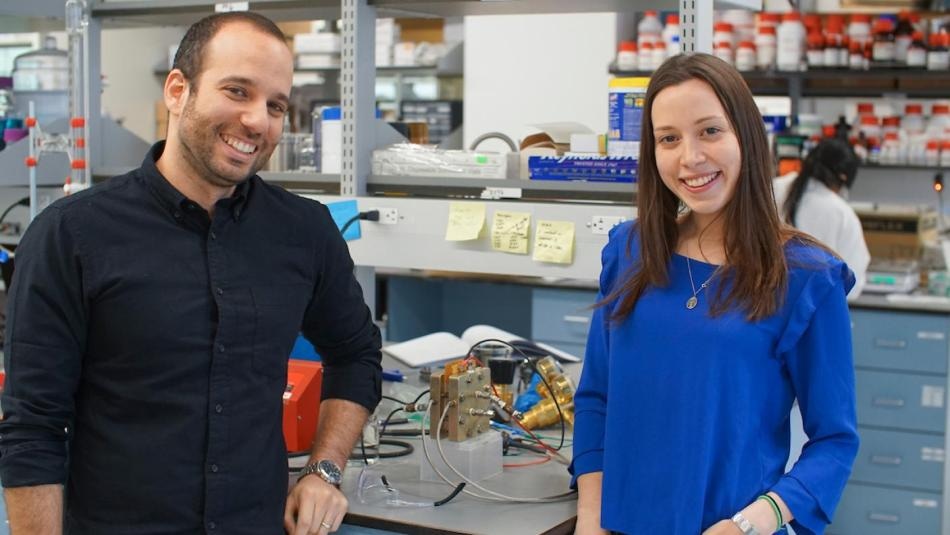Aug 27 2019
Instant access to dependable energy supplies, energy efficiency, water conservation, and waste reduction are challenges currently faced by the chemical and allied sectors.
 Miguel Modestino, professor of chemical and biomolecular engineering, and Daniela Blanco, a PhD student, pose with electrosynthesis device of their own design. The pair developed a new, green electro-synthetic route to adiponitrile and used artificial intelligence to improve upon it. (Image credit: The NYU Tandon School of Engineering)
Miguel Modestino, professor of chemical and biomolecular engineering, and Daniela Blanco, a PhD student, pose with electrosynthesis device of their own design. The pair developed a new, green electro-synthetic route to adiponitrile and used artificial intelligence to improve upon it. (Image credit: The NYU Tandon School of Engineering)
However, these difficulties could be resolved through organic electrosynthesis—an energy-efficient and electricity-driven process that easily combines with renewable energy sources.
At the NYU Tandon School of Engineering, researchers reported that in their quest to develop a novel, eco-friendly process to synthesize adiponitrile (ADN)—the key precursor to nylon 6, 6—they came across a method that can considerably enhance the efficiency of organic electrosynthesis.
The investigators partly attributed their success to what they assume is the first application of artificial intelligence (AI) to improve an electrochemical process.
Doctoral student Daniela Blanco and Miguel Modestino, a professor of chemical and biomolecular engineering, adjusted the way electrical current is supplied to catalytic electrodes and subsequently applied AI to further improve the reaction. When they did so, they noticed that ADN production improved as much as 30%.
These latest findings, described in the Proceedings of the National Academy of Sciences (PNAS), can hold significant implications because the researchers have targeted one among the largest organic electrosynthesis processes in the chemical sector—that is, the electrohydrodimerization of acrylonitrile (AN) to ADN.
There is an intense and increasing demand for ADN. In fact, the nylon market is anticipated to increase by 4% each year through 2023. At present, the electrochemical process invented by Monsanto is used by only one company to produce ADN; the largest share of the nylon precursor is made through an energy-intensive and harmful thermal hydrocyanation of butadiene.
Electrosynthesis of ADN, on the other hand, is an efficient and green chemical process that utilizes water-based electrolytes. It can be directly integrated with renewable electricity sources, like sunlight or wind.
In the typical electrosynthetic procedure for ADN, an “always on” direct electrical current is supplied to the electrocatalytic site. However, the NYU Tandon team observed that a direct current did not increase the ADN output and also produced a large amount of the unnecessary byproduct called propionitrile (PN).
Hence, the researchers decided to design a system that supplies an intermittent electrical current to continuously replenish the concentration of the reagent at the electrocatalytic site (this phenomenon is known as mass transport) and also maximize the output of ADN.
The team delivered an artificial neural network with data obtained from 16 varied experimental cases of pulse times.
By analyzing electrochemical pulse techniques with AI, we were able to visualize ADN conversion efficiency across a range of pulse times without having to do more than a few physical experiments. This innovative, integrated approach led to an unprecedented 30% improvement in ADN production and a 325% increase in the ratio of ADN to PN, mostly due to a large decrease in the production of the latter.
Miguel Modestino, Professor, Department of Chemical and Biomolecular Engineering, The NYU Tandon School of Engineering
Blanco elaborated that this method may increase the adoption of more sustainable processes in the industry. That is precisely what she and a former student in Modestino’s lab envisaged when they established a green-chemistry startup company called Sunthetics. The researchers’ aim was to commercialize a sustainable nylon production procedure based on their work.
We wanted to show with this new research that we can make the ADN electrochemical process more competitive. Currently only 30% of global ADN output employs electrosynthesis; the rest of production involves processing over an energy- and oil-intensive catalytic reactor.
Daniela Blanco, PhD Student, Department of Chemical and Biomolecular Engineering, The NYU Tandon School of Engineering
The subsequent step for the researchers will be to apply this AI technique to speed up their research endeavors.
“Instead of using a classical research model involving lengthy experimental campaigns, AI tools can help us predict experimental outcomes. To the best of our knowledge, this is the first time AI has been used to optimize an electrochemical process,” Modestino stated.
The paper titled “Optimizing organic electrosynthesis through controlled voltage dosing and artificial intelligence” can be accessed at https://www.pnas.org/content/early/2019/08/20/1909985116.
The study was partly funded by the H&M Foundation.